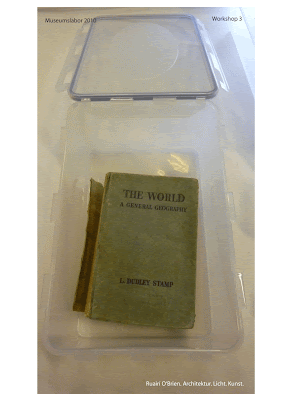 Workshop report III
Workshop report IIIIn the third workshop called "Wissbegierde" which could be translated as meaning "Thirst for knowledge" I undertook to analyse the chosen items which were placed into the “White Box” by the children I worked with in the first workshop "Schöpfung" or "Creation". I had not seen the contents of the “White box” for a couple of weeks and had forgotten the significance of one or the other of the objects. This was an exciting aspect to this workshop, opening the closed box, which had not been opened since the children were last in the "Museumslabor", and peering in. The objects reflected a colourful light onto the white walls of the vessel, they appeared to be jewel like and of great worth, in fact they are indeed now of great worth. Despite their actual worth in terms of initial cost, many of the objects were bought in the penny markets of Dresden, they now had acquired many levels of value in my eyes. Firstly they were the “chosen” items, which were initially part of a larger buying action of cheap toys, items of kitch, kitchen utensils and other everyday objects for example, intermingled with objects of great personal worth, a book from my father for example or a small oil painting. The children had selected these objects from my large black box, each child chose one object, and had placed them in the white box for the start of the "museumslabor" collection. These objects were touched by all these children, laughter and curiosity filled the chosen items with new meaning. Secondly the objects had now been sitting in their new found home, the State Art Museum, the SKD, for the last 5 weeks among some of the finest and most valuable treasures in the known world and were being protected by a 24 hour high-tech security guard system as good as any in the world. These seemingly "worthless" objects had become "Priceless" a transformation had taken place!

 We took the objects out of the white box and placed them carefully on the white laboratory work top. We inspected each object and discussed its origin. The objects were photographed from all sides in good light. Characteristics were noted and a description was agreed upon which was then transcribed to paper and placed in a folder for future generations. We discussed which type of protection each object needed and classified the objects into 3 categories, 1. High risk: 2. Middle risk: 3. Low risk: Each object received a number which was then attached to the object. The objects were then placed into protective boxes, sealable plastic envelopes or open baskets. All the objects were then placed into the “Museumlabor” installation. The "Erd-Mensch" recieved his box.
We took the objects out of the white box and placed them carefully on the white laboratory work top. We inspected each object and discussed its origin. The objects were photographed from all sides in good light. Characteristics were noted and a description was agreed upon which was then transcribed to paper and placed in a folder for future generations. We discussed which type of protection each object needed and classified the objects into 3 categories, 1. High risk: 2. Middle risk: 3. Low risk: Each object received a number which was then attached to the object. The objects were then placed into protective boxes, sealable plastic envelopes or open baskets. All the objects were then placed into the “Museumlabor” installation. The "Erd-Mensch" recieved his box.We discussed the collection and asked questions about the previous owners of each object. Curiosity was awakened about the history of the objects and their “travels”, where they came from? What kind of journey did they undergo? Who was the last owner? Who made the objects? Why were they made? What purpose? Were the objects loved or appreciated, misused, forgotten, lost or found? Was the object “Unique”? Was there a second one in the world similar? If so should we obtain it, add it to our collection? Would a second matching object increase the value of the first? Etc
To finish we walked through the “Zukunft seit 1560. The Exhibition” and looked for similar objects which we could match with our collection. Boxes, utensils, instruments, paintings, jewels, books, maps Etc. A last question was asked; Were these objects of more value than our "New objects" collected in the "Museumslabor"? If the answer is yes then why? What is if the answer is no?
This is a book I recieved from my father as a child in Dublin.
 The museumslabor is now exhibiting its "collection"
The museumslabor is now exhibiting its "collection"
 The museumslabor is now exhibiting its "collection"
The museumslabor is now exhibiting its "collection"The next workshop will take place on Wednesday the 9th of June 2010.
The subject is "Konfrontation" which could be translated as meaning "Confrontation".
Ruairí O'Brien


Keine Kommentare:
Kommentar veröffentlichen